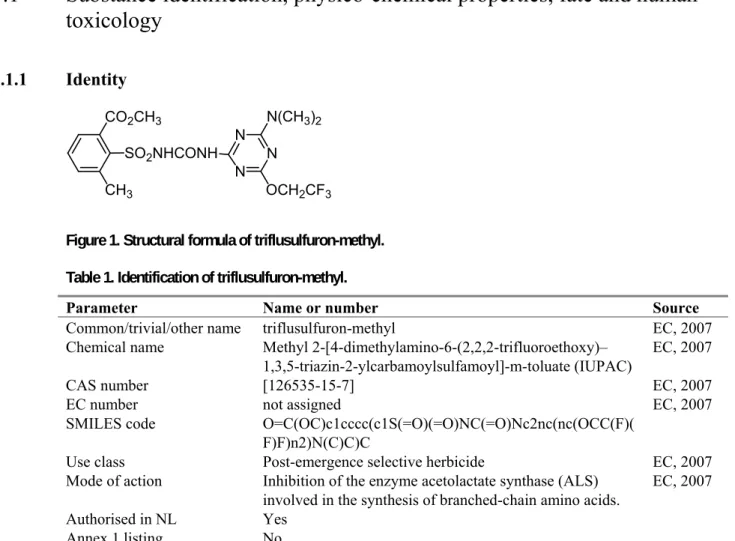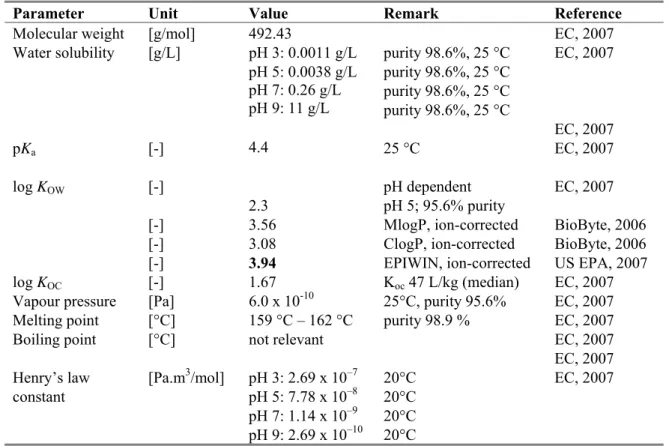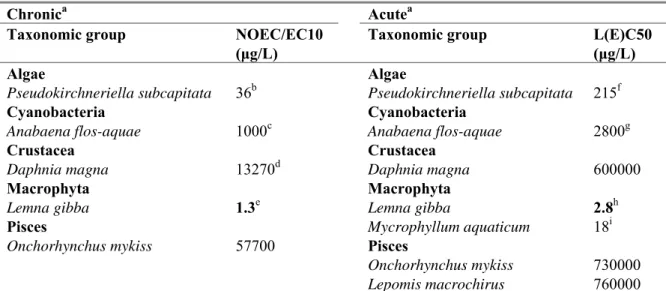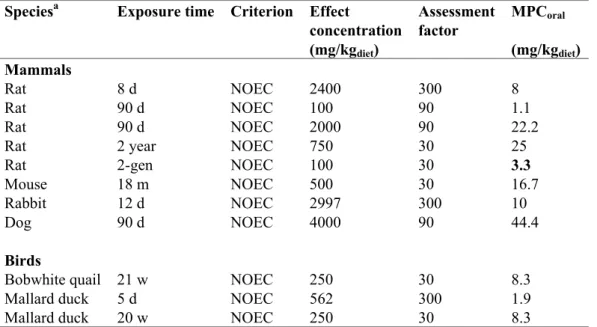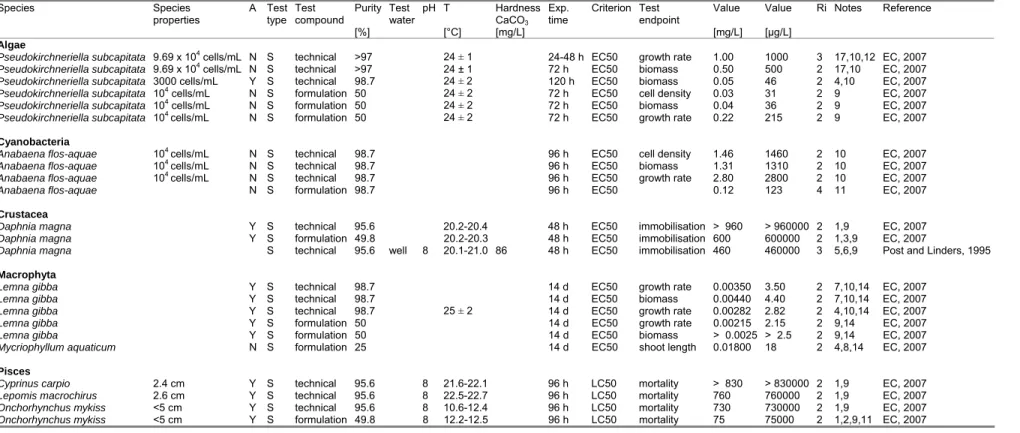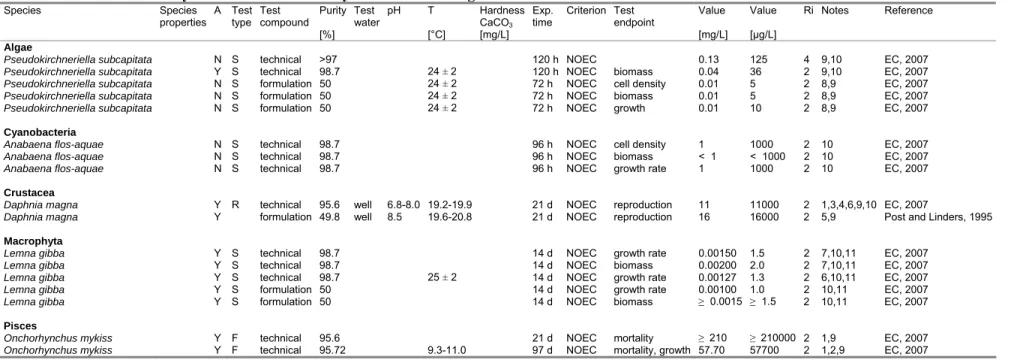Environmental risk limits for
triflusulfuron-methyl
Letter report 601716002/2008
RIVM Letter report 601716002/2008
Environmental risk limits for triflusulfuron-methyl
Jacqueline W.A. Scheepmaker
Contact:
Jacqueline W.A. Scheepmaker Expertise Centre for Substances Jacqueline.Scheepmaker@rivm.nl
This investigation has been performed by order and for the account of Directorate-General for
Environmental Protection, Directorate for Soil, Water and Rural Area (BWL), within the framework of the project 'Standard setting for other relevant substances within the WFD'.
© RIVM 2008
Parts of this publication may be reproduced, provided acknowledgement is given to the 'National Institute for Public Health and the Environment', along with the title and year of publication.
Rapport in het kort
Environmental risk limits for triflusulfuron-methyl
Dit rapport geeft milieurisicogrenzen voor het herbicide triflusulfuron-methyl in water. Milieurisicogrenzen zijn de technisch-wetenschappelijke advieswaarden voor de uiteindelijke
milieukwaliteitsnormen in Nederland. De milieurisicogrenzen zijn afgeleid volgens de methodiek die is voorgeschreven in de Europese Kaderrichtlijn Water. Hierbij is gebruikgemaakt van de beoordeling in het kader van de Europese toelating van gewasbeschermingsmiddelen (Richtlijn 91/414/EEG), aangevuld met gegevens uit de openbare literatuur.
Contents
1 Introduction 7
1.1 Background and scope of the report 7
1.2 Status of the results 7
2 Methods 8
2.1 Data collection 8
2.2 Data evaluation and selection 8
2.3 Derivation of ERLs 9
2.3.1 Drinking water 9
3 Derivation of environmental risk limits for triflusulfuron-methyl 11 3.1 Substance identification, physico-chemical properties, fate and human toxicology 11
3.1.1 Identity 11
3.1.2 Physico-chemical properties 12
3.1.3 Behaviour in the environment 12
3.1.4 Bioconcentration and biomagnification 13
3.1.5 Human toxicological threshold limits and carcinogenicity 13
3.2 Trigger values 13
3.3 Toxicity data and derivation of ERLs for water 14
3.3.1 MPCeco, water and MPCeco, marine 14
3.3.2 MPCsp, water and MPCsp, marine 15
3.3.3 MPChh food, water 16
3.3.4 MPCdw, water 16
3.3.5 Selection of the MPCwater and MPCmarine 16
3.3.6 MACeco 16
3.3.7 SRCeco, water 16
3.4 Toxicity data and derivation of ERLs for sediment 16
4 Conclusions 17
References 18
Appendix 1. Detailed aquatic toxicity data 19
Appendix 2. Detailed bird and mammal toxicity data 21 Appendix 3. References used in the appendices 22
1
Introduction
1.1
Background and scope of the report
In this report, environmental risk limits (ERLs) for surface water are derived for the herbicide triflusulfuron-methyl. The derivation is performed within the framework of the project ‘Standard setting for other relevant substances within the WFD’, which is closely related to the project
‘International and national environmental quality standards for substances in the Netherlands’ (INS). Triflusulfuron-methyl is part of a series of 25 pesticides that appeared to have a high environmental impact in the evaluation of the policy document on sustainable crop protection (‘Tussenevaluatie van de nota Duurzame Gewasbescherming’; MNP, 2006) and/or were selected by the Water Boards (‘Unie van Waterschappen’; project ‘Schone Bronnen’; http://www.schonebronnen.nl/).
The following ERLs are considered:
• Maximum Permissible Concentration (MPC) – the concentration protecting aquatic ecosystems and humans from effects due to long-term exposure
• Maximum Acceptable Concentration (MACeco) – the concentration protecting aquatic ecosystems
from effects due to short-term exposure or concentration peaks.
• Serious Risk Concentration (SRCeco) – the concentration at which possibly serious ecotoxicological
effects are to be expected.
More specific, the following ERLs can be derived depending on the availability of data and characteristics of the compound:
MPCeco, water MPC for freshwater based on ecotoxicological data (direct exposure)
MPCsp, water MPC for freshwater based on secondary poisoning
MPChh food, water MPC for fresh and marine water based on human consumption of fishery products
MPCdw, water MPC for surface waters intended for the abstraction of drinking water
MACeco, water MAC for freshwater based on ecotoxicological data (direct exposure)
SRCeco, water SRC for freshwater based on ecotoxicological data (direct exposure)
MPCeco, marine MPC for marine water based on ecotoxicological data (direct exposure)
MPCsp, marine MPC for marine water based on secondary poisoning
MACeco, marine MAC for marine water based on ecotoxicological data (direct exposure)
1.2
Status of the results
The results presented in this report have been discussed by the members of the scientific advisory group for the INS-project (WK-INS). It should be noted that the Environmental Risk Limits (ERLs) in this report are scientifically derived values, based on (eco)toxicological, fate and physico-chemical data. They serve as advisory values for the Dutch Steering Committee for Substances, which is appointed to set the Environmental Quality Standards (EQSs). ERLs should thus be considered as proposed values that do not have any official status.
2
Methods
The methodology for the derivation of ERLs is described in detail by Van Vlaardingen and Verbruggen (2007), further referred to as the ‘INS-Guidance’. This guidance is in accordance with the guidance of the Fraunhofer Institute (FHI; Lepper, 2005).
The process of ERL-derivation contains the following steps: data collection, data evaluation and selection, and derivation of the ERLs on the basis of the selected data.
2.1
Data collection
In accordance with the WFD, data of existing evaluations were used as a starting point. For
triflusulfuron-methyl, the evaluation report prepared within the framework of EU Directive 91/414/EC (Draft Assessment Report, DAR) was consulted (EC, 2007; further referred to as DAR). An on-line literature search was performed on TOXLINE (literature from 1985 to 2001) and Current contents (literature from 1997 to 2007). In addition to this, all potentially relevant references in the RIVM e-tox base and EPA’s ECOTOX database were checked.
2.2
Data evaluation and selection
For substance identification, physico-chemical properties and environmental behaviour, information from the List of Endpoints of the DAR was used. When needed, additional information was included according to the methods as described in Section 2.1 of the INS-Guidance. Information on human toxicological threshold limits and classification was also primarily taken from the DAR.
Ecotoxicity studies (including bird and mammal studies) were screened for relevant endpoints (i.e. those endpoints that have consequences at the population level of the test species). All ecotoxicity and bioaccumulation tests were then thoroughly evaluated with respect to the validity (scientific reliability) of the study. A detailed description of the evaluation procedure is given in the INS-Guidance (see Section 2.2.2 and 2.3.2). In short, the following reliability indices were assigned:
- Ri 1: Reliable without restriction
’Studies or data … generated according to generally valid and/or internationally accepted testing guidelines (preferably performed according to GLP) or in which the test parameters documented are based on a specific (national) testing guideline … or in which all parameters described are closely related/comparable to a guideline method.’
- Ri 2: Reliable with restrictions
’Studies or data … (mostly not performed according to GLP), in which the test parameters
documented do not totally comply with the specific testing guideline, but are sufficient to accept the data or in which investigations are described which cannot be subsumed under a testing guideline, but which are nevertheless well documented and scientifically acceptable.’
- Ri 3: Not reliable
’Studies or data … in which there are interferences between the measuring system and the test substance or in which organisms/test systems were used which are not relevant in relation to the exposure (e.g., unphysiologic pathways of application) or which were carried out or generated
according to a method which is not acceptable, the documentation of which is not sufficient for an assessment and which is not convincing for an expert judgment.’
- Ri 4: Not assignable
’Studies or data … which do not give sufficient experimental details and which are only listed in short abstracts or secondary literature (books, reviews, etc.).’
All available studies were summarised in data-tables, that are included as Annexes to this report. These tables contain information on species characteristics, test conditions and endpoints. Explanatory notes are included with respect to the assignment of the reliability indices.
With respect to the DAR, it was chosen not to re-evaluate the underlying studies. In principle, the endpoints that were accepted in the DAR were also accepted for ERL-derivation with Ri 2, except in cases where the reported information was too poor to decide on the reliability or when there was reasonable doubt on the validity of the tests. This applies especially to DARs prepared in the early 1990s, which do not always meet the current standards of evaluation and reporting.
In some cases, the characteristics of a compound (i.e. fast hydrolysis, strong sorption, low water solubility) put special demands on the way toxicity tests are performed. This implies that in some cases endpoints were not considered reliable, although the test was performed and documented according to accepted guidelines. If specific choices were made for assigning reliability indices, these are outlined in Section 3.3 of this report.
Endpoints with Ri 1 or 2 are accepted as valid, but this does not automatically mean that the endpoint is selected for the derivation of ERLs. The validity scores are assigned on the basis of scientific
reliability, but valid endpoints may not be relevant for the purpose of ERL-derivation (e.g. due to inappropriate exposure times or test conditions that are not relevant for the Dutch situation).
After data collection and validation, toxicity data were combined into an aggregated data table with one effect value per species according to Section 2.2.6 of the INS-Guidance. When for a species several effect data were available, the geometric mean of multiple values for the same endpoint was calculated where possible. Subsequently, when several endpoints were available for one species, the lowest of these endpoints (per species) is reported in the aggregated data table.
2.3
Derivation of ERLs
For a detailed description of the procedure for derivation of the ERLs, reference is made to the INS-Guidance. With respect to the selection of the final MPCwater, some additional comments should be
made:
2.3.1
Drinking water
The INS-Guidance includes the MPC for surface waters intended for the abstraction of drinking water (MPCdw, water) as one of the MPCs from which the lowest value should be selected as the general
MPCwater (see INS-Guidance, Section 3.1.6 and 3.1.7). According to the proposal for the daughter
directive Priority Substances, however, the derivation of the AA-EQS (= MPC) should be based on direct exposure, secondary poisoning, and human exposure due to the consumption of fish. Drinking water was not included in the proposal and is thus not guiding for the general MPC value. The exact way of implementation of the MPCdw, water in the Netherlands is at present under discussion within the
framework of the “AMvB Kwaliteitseisen en Monitoring Water”. No policy decision has been taken yet, and the MPCdw, water is therefore presented as a separate value in this report. The MPCwater, is thus
derived considering the individual MPCs based on direct exposure (MPCeco, water), secondary poisoning
(MPCsp, water) or human consumption of fishery products (MPChh food, water); derivation of the latter two is
dependent on the characteristics of the compound.
Related to this, is the inclusion of water treatment for the derivation of the MPCdw, water. According to
the INS-Guidance (see Section 3.1.7), a substance specific removal efficiency related to simple water treatment should be derived in case the MPCdw, water is lower than the other MPCs. For pesticides, there
is no agreement as yet on how the removal fraction should be calculated, and water treatment is therefore not taken into account. In case no A1 value is set in Directive 75/440/EEC, the MPCdw, water is
set to the general Drinking Water Standard of 0.1 µg/L for organic pesticides as specified in Directive 98/83/EC.
3
Derivation of environmental risk limits for
triflusulfuron-methyl
3.1
Substance identification, physico-chemical properties, fate and human
toxicology
3.1.1
Identity
SO2NHCONH N N N N(CH3)2 OCH2CF3 CH3 CO2CH3 Figure 1. Structural formula of triflusulfuron-methyl. Table 1. Identification of triflusulfuron-methyl.Parameter Name or number Source
Common/trivial/other name triflusulfuron-methyl EC, 2007
Chemical name Methyl 2-[4-dimethylamino-6-(2,2,2-trifluoroethoxy)– 1,3,5-triazin-2-ylcarbamoylsulfamoyl]-m-toluate (IUPAC)
EC, 2007
CAS number [126535-15-7] EC, 2007
EC number not assigned EC, 2007
SMILES code O=C(OC)c1cccc(c1S(=O)(=O)NC(=O)Nc2nc(nc(OCC(F)(
F)F)n2)N(C)C)C
Use class Post-emergence selective herbicide EC, 2007
Mode of action Inhibition of the enzyme acetolactate synthase (ALS) involved in the synthesis of branched-chain amino acids.
EC, 2007
Authorised in NL Yes
3.1.2
Physico-chemical properties
Table 2. Physico-chemical properties of triflusulfuron-methyl.
Parameter Unit Value Remark Reference
Molecular weight [g/mol] 492.43 EC, 2007
Water solubility [g/L] pH 3: 0.0011 g/L pH 5: 0.0038 g/L pH 7: 0.26 g/L pH 9: 11 g/L purity 98.6%, 25 °C purity 98.6%, 25 °C purity 98.6%, 25 °C purity 98.6%, 25 °C EC, 2007 EC, 2007 pKa [-] 4.4 25 °C EC, 2007 log KOW [-] 2.3 pH dependent pH 5; 95.6% purity EC, 2007
[-] 3.56 MlogP, ion-corrected BioByte, 2006
[-] 3.08 ClogP, ion-corrected BioByte, 2006
[-] 3.94 EPIWIN, ion-corrected US EPA, 2007
log KOC [-] 1.67 Koc 47 L/kg (median) EC, 2007
Vapour pressure [Pa] 6.0 x 10-10 25°C, purity 95.6% EC, 2007
Melting point [°C] 159 °C – 162 °C purity 98.9 % EC, 2007
Boiling point [°C] not relevant EC, 2007
EC, 2007 Henry’s law constant [Pa.m3/mol] pH 3: 2.69 x 10–7 pH 5: 7.78 x 10–8 pH 7: 1.14 x 10–9 pH 9: 2.69 x 10–10 20°C 20°C 20°C 20°C EC, 2007
The estimated log Kow of 3.94 is selected as the worst-case value for ERL-derivation.
3.1.3
Behaviour in the environment
Table 3. Selected environmental properties of triflusulfuron-methyl.
Parameter Unit Value Remark Reference
Hydrolysis half-life DT50 [d] 3.7 32 36 pH 5 pH 7 pH 9 EC, 2007 Photolysis half-life DT50 [d] 3.8 13.9 24.6 pH 5 pH 7 pH 9 EC, 2007
Readily biodegradable no EC, 2007
Water/sediment systems DT50 [d] 21-39 system EC, 2007
Relevant metabolites IN-W6725 = methyl saccharin IN-D8526 = triazine amine
IN-E0Q47 = N-desmethyl triazine amine IN-66036 = N-desmethyl triflusulfuron-methyl
3.1.4
Bioconcentration and biomagnification
An overview of the bioaccumulation data for triflusulfuron-methyl is given in Table 4. Table 4. Overview of bioaccumulation data for triflusulfuron-methyl.
Parameter Unit Value Remark Reference
BCF (fish) [L/kg] 446 QSAR with log Kow 3.94 Veith et al., 1979
BMF [kg/kg] 1 Default value for log Kow < 4.5
3.1.5
Human toxicological threshold limits and carcinogenicity
Triflusulfuron-methyl is proposed to be classified Carcinogenic cat.3 in the DAR, and R40 is assigned. The ADI was set at 0.04 mg/kgbw/d, based on the NOAEL of 4.0 mg/kgbw/d from a two-year study in
the rat, with a safety factor of 100.
3.2
Trigger values
This section reports on the trigger values for ERLwater derivation (as demanded in WFD framework). Table 5. Triflusulfuron-methyl: collected properties for comparison to MPC triggers.
Parameter Value Unit Method/Source Derived at
section
Log Kp,susp-water 0.67 [-] KOC × fOC,susp1 KOC: 3.1.2
BCF 446 [L/kg] 3.1.4
BMF 1 [-] 3.1.4
Log KOW 3.94 [-] 3.1.2
R-phrases R 40, R53 [-] 3.1.5
A1 value 1 [μg/L] Total pesticides
DW standard 0.1 [μg/L] General value for organic pesticides
1 fOC,susp = 0.1 kgOC/kgsolid (EC, 2003).
o triflusulfuron-methyl has a log Kp, susp-water < 3; derivation of MPCsediment is not triggered.
o triflusulfuron-methyl has a log Kp, susp-water < 3; expression of the MPCwater as MPCsusp, water is not
required.
o triflusulfuron-methyl has a log Kow ≥ 3; assessment of secondary poisoning is triggered.
o triflusulfuron-methyl has an R40 classification. Therefore, an MPCwater for human health via food (fish) consumption (MPChh food, water) should be derived.
o For triflusulfuron-methyl, no specific A1 value or Drinking Water Standard is available from Council Directives 75/440, EEC and 98/83/EC, respectively. Therefore, the general Drinking Water Standard for organic pesticides applies.
3.3
Toxicity data and derivation of ERLs for water
3.3.1
MPC
eco, waterand MPC
eco, marineAn overview of the selected freshwater toxicity data for triflusulfuron-methyl is given in Table 6. There are no valid marine toxicity data available. Detailed toxicity data for triflusulfuron-methyl are tabulated in Appendix 2.
With respect to macrophyta, the following should be noted. For Lemna gibba and Mycrophyllum
aquaticum, EC50 and NOEC-values are available from a 14-days test. In view of the generation time of
these species, 14 days is considered as chronic. However, when omitting the EC50s from the acute
dataset, the most sensitive species group would not be included in the derivation of the MAC. It is considered that the 14-days EC50s are representative for shorter test durations, and therefore, the data
are treated as acute.
Table 6. Triflusulfuron-methyl: selected freshwater toxicity data for ERL derivation.
Chronica Acutea
Taxonomic group NOEC/EC10 (μg/L)
Taxonomic group L(E)C50 (μg/L)
Algae Algae
Pseudokirchneriella subcapitata 36b Pseudokirchneriella subcapitata 215f
Cyanobacteria Cyanobacteria
Anabaena flos-aquae 1000c Anabaena flos-aquae 2800g
Crustacea Crustacea
Daphnia magna 13270d Daphnia magna 600000
Macrophyta Macrophyta
Lemna gibba 1.3e Lemna gibba 2.8h
Pisces Mycrophyllum aquaticum 18i
Onchorhynchus mykiss 57700 Pisces
Onchorhynchus mykiss 730000
Lepomis macrochirus 760000
a For detailed information see Appendix 2. Bold values are used for ERL derivation. b endpoint biomass in the absence of growth rate data for the active substance c preferred endpoint growth rate
d geometric mean of 11000 and 16000 μg/L, endpoint reproduction e geometric mean of 1.5, 1.3 and 1.0 μg/L; preferred endpoint growth rate f preferred endpoint growth rate
g preferred endpoint growth rate
h geometric mean of 3.50, 2.82 and 2.15 μg/L; preferred endpoint growth rate i based on nominal concentration with shoot length as endpoint
3.3.1.1 Treatment of fresh- and saltwater toxicity data
ERLs for freshwater and marine waters should be derived separately. For pesticides, data can only be combined if it is possible to determine with high probability that marine organisms are not more sensitive than freshwater organisms (Lepper, 2005). For triflusulfuron-methyl, no marine toxicity data are available and ERLs for the marine compartment cannot be derived.
3.3.1.2 Mesocosm and field studies
3.3.1.3 Derivation of MPCeco, water and MPCeco, marine
The base set is complete. Chronic data are available for five species in the taxonomic groups of fish, crustacea, algae, cyanobacteria and macrophyta. An assessment factor of 10 is applied to the lowest NOEC of 1.3 μg/L for macrophyta. The MPCeco, water is 0.13 μg/L.
Due to the absence of marine data, the MPCeco, marine cannot be derived.
3.3.2
MPC
sp, waterand MPC
sp, marineTriflusulfuron-methyl has a log Kow ≥ 3, the assessment of secondary poisoning is triggered. The
available toxicity data for mammals and birds are presented in Appendix 4. In Table 7, the MPCoral is
derived applying the appropriate assessment factors to the data. No default assessment factors are available for 8- and 12-days NOEC for mammals, and a 5-days NOEC for birds. In these cases, a factor of 300 is used.
Table 7. triflusulfuron-methyl: selected mammal and bird data for ERL derivation Speciesa Exposure time Criterion Effect
concentration (mg/kgdiet) Assessment factor MPCoral (mg/kgdiet) Mammals Rat 8 d NOEC 2400 300 8 Rat 90 d NOEC 100 90 1.1 Rat 90 d NOEC 2000 90 22.2
Rat 2 year NOEC 750 30 25
Rat 2-gen NOEC 100 30 3.3
Mouse 18 m NOEC 500 30 16.7
Rabbit 12 d NOEC 2997 300 10
Dog 90 d NOEC 4000 90 44.4
Birds
Bobwhite quail 21 w NOEC 250 30 8.3
Mallard duck 5 d NOEC 562 300 1.9
Mallard duck 20 w NOEC 250 30 8.3
a For detailed information see Appendix 4. Bold values are used for ERL derivation.
The lowest MPCoral, duck for Mallard ducks is 1.9 mg/kgdiet, based on a short-term toxicity study. There
are, however, also long-term data available, which according to the INS-Guidance prevail over the short-term study. The MPCoral, duck for Mallard ducks based on the long-term test is 8.3 mg/kgdiet. For
rats, there are also chronic data available which prevail over the short-term tests. The 2-year study is considered less reliable because in this study there was a high mortality and effects on body weight were observed in females only. The MPCoral, rat is therefore set to 3.3 mg/kgdiet, and this value is
selected for MPC-derivation.
The MPCsp, water = MPCoral, min / (BCF × BMF) = 3.3 / (446 × 1) = 7.4 × 10-3 mg/L = 7.4 µg/L.
Because toxicity data for marine predators are generally not available, the MPCoral, min as derived above
is used as a representative for the marine environment also. To account for the longer food chains in the marine environment, an additional biomagnification step is introduced (BMF2). This factor is the same
as given in Table 4. The MPCsp, marine = MPCoral, min / (BCF × BMF1 × BMF2) = 3.3 / (446 × 1 × 1) = 7.4
3.3.3
MPC
hh food, waterDerivation of MPChh food,water for triflusulfuron-methyl is triggered (Table 5). The MPChh food is
calculated from the ADI (0.04 mg/kgbw/d), a body weight of 70 kg and a daily fish consumption of 115
g, as MPC hh food = 0.04 x 0.1 x 70/0.115 = 2.4 mg/kg.
Subsequently the MPChh food, water is calculated as 2.4 / (BCFfish x BMF1) = 2.4 / (446 x 1) = 5.4 x 10-3
mg/L = 5.4 µg/L.
3.3.4
MPC
dw, waterThe Drinking Water Standard is 0.1 µg/L. Thus, the MPCdw, water is also 0.1 µg/L.
3.3.5
Selection of the MPC
waterand MPC
marineThe lowest value of the routes included (see Section 2.3.1) is the ecotoxicological MPCeco, water. The
MPCwater = 0.13 µg/L.
No MPCmarine can be selected due to the absence of data.
3.3.6
MAC
eco3.3.6.1 MACeco, water
The MACeco is based on the acute toxicity data. The base set is complete. Triflusulfuron-methyl has a
potential to bioaccumulate (log Kow ≥ 3), has a known mode of action and the potentially most
sensitive species groups (algae and macrophyta) are included in the dataset. Therefore, the default assessment factor of 100 applies. It is considered justified to lower this assessment factor to 10 because of the following:
• There is no concern for effects due to bioaccumulation, because toxicity for fish is low (LC50 730 –
760 mg/L) and bioaccumulation is considered not relevant for macrophytes.
• Five EC50 values are available for Lemna gibba and one for Mycrophyllum aquaticum. L. gibba is
the most sensitive of the two species, selected EC50 values are 2.15, 2.82 and 3.50 µg/L with a
geometric EC50 of 2.8 µg/L. It is assumed that this most sensitive species will be protected by a
assessment factor of 10.
The MACeco, water is therefore set to 0.28 µg/L. 3.3.6.2 MACeco, marine
Due to the absence of marine data, the MACeco, marine cannot be derived.
3.3.7
SRC
eco, waterNOECs are available for five taxa, including algae, Daphnia and fish. The SRCeco, water is therefore
derived as the geometric mean of all available NOECs with an assessment factor of 1. The SRCeco, water
is 514 µg/L (data fit a log-normal distribution).
3.4
Toxicity data and derivation of ERLs for sediment
The log Kp, susp-water of triflusulfuron-methyl is below the trigger value of 3, therefore, ERLs are not
4
Conclusions
In this report, the risk limits Maximum Permissible Concentration (MPC), Maximum Acceptable Concentration for ecosystems (MACeco), and Serious Risk Concentration for ecosystems (SRCeco) are
derived for triflusulfuron-methyl in water. No risk limits were derived for the marine compartment because data were not available. Derivation of risk limits for sediment was not triggered.
The ERLs that were obtained are summarised in the table below. The MPC value that was set for this compound until now, is also presented in this table for comparison reasons. It should be noted that this is an indicative MPC (‘ad-hoc MTR’), derived using a different methodology and based on limited data.
Table 7. Derived MPC, MACeco, and SRC values for triflusulfuron-methyl.
ERL Unit MPC MACeco SRC
Water, olda µg/L 0.23 - -
Water, newb µg/L 0.13 0.28 5.1 x 102
Drinking waterb µg/L 0.1c - -
Marine µg/L n.d.d n.d.d -
a indicative MPC (‘ad-hoc MTR’), source: Helpdesk
Waterhttp://www.helpdeskwater.nl/emissiebeheer/normen_voor_het/zoeksysteem_normen/
b The MPC
dw, water is reported as a separate value from the other MPCwater values (MPCeco, water, MPCsp, water or
MPChh food, water). From these other MPC water values (thus excluding the MPCdw, water) the lowest one is selected as
the ‘overall’ MPCwater.
c provisional value pending the decision on implementation of the MPC
dw, water, (see Section 2.3.1) d n.d. = not derived due to lack of data
References
Biobyte. 2006. Bio-Loom for Windows. Version 1.5. Claremont, USA: Biobyte Corp.
EC. 2007. Draft Assessment Report triflusulfuron-methyl. Rapporteur Member State France. May 2007.
EC. 2003. Technical Guidance Document in support of Commission Directive 93/67/EEC on Risk Assessment for new notified substances, Commission Regulation (EC) No 1488/94 on Risk Assessment for existing substances and Directive 98/9/EC of the European Parliament and of the Council concerning the placing of biocidal products on the market. Part II. Ispra, Italy: European Chemicals Bureau, Institute for Health and Consumer Protection. Report no. EUR 20418 EN/2. Lepper P. 2005. Manual on the Methodological Framework to Derive Environmental Quality Standards
for Priority Substances in accordance with Article 16 of the Water Framework Directive (2000/60/EC). 15 September 2005 (unveröffentlicht) ed. Schmallenberg, Germany: Fraunhofer-Institute Molecular Biology and Applied Ecology.
MNP. 2006. Tussenevaluatie van de nota Duurzame gewasbescherming. Bilthoven, The Netherlands: Milieu- en Natuurplanbureau. MNP-publicatienummer: 500126001.
Van Vlaardingen PLA, Verbruggen EMJ. 2007. Guidance for the derivation of environmental risk limits within the framework of 'International and national environmental quality standards for substances in the Netherlands' (INS). Bilthoven, The Netherlands: National Institute for Public Health and the Environment (RIVM). Report no. 601782001. 146 pp.
Veith GD, Defoe DL, Bergstedt BV. 1979. Measuring and estimating the bioconcentration factor of chemicals in fish. J Fish Res Board Can 36: 1040-1048.
Appendix 1. Detailed aquatic toxicity data
Table A1.1. Acute toxicity of triflusulfuron-methyl to freshwater organisms.Species Species A Test Test Purity Test pH T Hardness Exp. Criterion Test Value Value Ri Notes Reference
properties type compound water CaCO3 time endpoint
[%] [°C] [mg/L] [mg/L] [µg/L]
Algae
Pseudokirchneriella subcapitata 9.69 x 104 cells/mL N S technical >97 24 ± 1 24-48 h EC50 growth rate 1.00 1000 3 17,10,12 EC, 2007
Pseudokirchneriella subcapitata 9.69 x 104 cells/mL N S technical >97 24 ± 1 72 h EC50 biomass 0.50 500 2 17,10 EC, 2007
Pseudokirchneriella subcapitata 3000 cells/mL Y S technical 98.7 24 ± 2 120 h EC50 biomass 0.05 46 2 4,10 EC, 2007
Pseudokirchneriella subcapitata 104 cells/mL N S formulation 50 24 ± 2 72 h EC50 cell density 0.03 31 2 9 EC, 2007
Pseudokirchneriella subcapitata 104 cells/mL N S formulation 50 24 ± 2 72 h EC50 biomass 0.04 36 2 9 EC, 2007
Pseudokirchneriella subcapitata 104 cells/mL N S formulation 50 24 ± 2 72 h EC50 growth rate 0.22 215 2 9 EC, 2007
Cyanobacteria
Anabaena flos-aquae 104 cells/mL N S technical 98.7 96 h EC50 cell density 1.46 1460 2 10 EC, 2007 Anabaena flos-aquae 104 cells/mL N S technical 98.7 96 h EC50 biomass 1.31 1310 2 10 EC, 2007
Anabaena flos-aquae 104 cells/mL N S technical 98.7 96 h EC50 growth rate 2.80 2800 2 10 EC, 2007
Anabaena flos-aquae N S formulation 98.7 96 h EC50 0.12 123 4 11 EC, 2007
Crustacea
Daphnia magna Y S technical 95.6 20.2-20.4 48 h EC50 immobilisation > 960 > 960000 2 1,9 EC, 2007
Daphnia magna Y S formulation 49.8 20.2-20.3 48 h EC50 immobilisation 600 600000 2 1,3,9 EC, 2007
Daphnia magna S technical 95.6 well 8 20.1-21.0 86 48 h EC50 immobilisation 460 460000 3 5,6,9 Post and Linders, 1995
Macrophyta
Lemna gibba Y S technical 98.7 14 d EC50 growth rate 0.00350 3.50 2 7,10,14 EC, 2007
Lemna gibba Y S technical 98.7 14 d EC50 biomass 0.00440 4.40 2 7,10,14 EC, 2007
Lemna gibba Y S technical 98.7 25 ± 2 14 d EC50 growth rate 0.00282 2.82 2 4,10,14 EC, 2007
Lemna gibba Y S formulation 50 14 d EC50 growth rate 0.00215 2.15 2 9,14 EC, 2007
Lemna gibba Y S formulation 50 14 d EC50 biomass > 0.0025 > 2.5 2 9,14 EC, 2007
Mycriophyllum aquaticum N S formulation 25 14 d EC50 shoot length 0.01800 18 2 4,8,14 EC, 2007
Pisces
Cyprinus carpio 2.4 cm Y S technical 95.6 8 21.6-22.1 96 h LC50 mortality > 830 > 830000 2 1,9 EC, 2007
Lepomis macrochirus 2.6 cm Y S technical 95.6 8 22.5-22.7 96 h LC50 mortality 760 760000 2 1,9 EC, 2007
Onchorhynchus mykiss <5 cm Y S technical 95.6 8 10.6-12.4 96 h LC50 mortality 730 730000 2 1,9 EC, 2007
Onchorhynchus mykiss <5 cm Y S formulation 49.8 8 12.2-12.5 96 h LC50 mortality 75 75000 2 1,2,9,11 EC, 2007
NOTES
1 based on mean measured concentrations 8 not performed under GLP, not according to test guideline
2 150 mg formulation/L 9 according to OECD guidelines
3 1200 mg formulation/L 10 according to US-EPA pesticide assessment Guidelines
4 measured but based on nominal since initial mean measured concentrations were >80% of nominal 11 formulation > factor 3 more active than active substance and is therefore not used for calculating the geomean
5 not measured, based on nominal concentrations 12 growth calculated over 24 h only
6 precipitation at all test concentrations 13 endpoint not given
Table A1.2. Chronic toxicity of triflusulfuron-methyl to freshwater organisms.
Species Species A Test Test Purity Test pH T Hardness Exp. Criterion Test Value Value Ri Notes Reference
properties type compound water CaCO3 time endpoint
[%] [°C] [mg/L] [mg/L] [µg/L]
Algae
Pseudokirchneriella subcapitata N S technical >97 120 h NOEC 0.13 125 4 9,10 EC, 2007
Pseudokirchneriella subcapitata Y S technical 98.7 24 ± 2 120 h NOEC biomass 0.04 36 2 9,10 EC, 2007
Pseudokirchneriella subcapitata N S formulation 50 24 ± 2 72 h NOEC cell density 0.01 5 2 8,9 EC, 2007
Pseudokirchneriella subcapitata N S formulation 50 24 ± 2 72 h NOEC biomass 0.01 5 2 8,9 EC, 2007
Pseudokirchneriella subcapitata N S formulation 50 24 ± 2 72 h NOEC growth 0.01 10 2 8,9 EC, 2007
Cyanobacteria
Anabaena flos-aquae N S technical 98.7 96 h NOEC cell density 1 1000 2 10 EC, 2007
Anabaena flos-aquae N S technical 98.7 96 h NOEC biomass < 1 < 1000 2 10 EC, 2007
Anabaena flos-aquae N S technical 98.7 96 h NOEC growth rate 1 1000 2 10 EC, 2007
Crustacea
Daphnia magna Y R technical 95.6 well 6.8-8.0 19.2-19.9 21 d NOEC reproduction 11 11000 2 1,3,4,6,9,10 EC, 2007
Daphnia magna Y formulation 49.8 well 8.5 19.6-20.8 21 d NOEC reproduction 16 16000 2 5,9 Post and Linders, 1995
Macrophyta
Lemna gibba Y S technical 98.7 14 d NOEC growth rate 0.00150 1.5 2 7,10,11 EC, 2007
Lemna gibba Y S technical 98.7 14 d NOEC biomass 0.00200 2.0 2 7,10,11 EC, 2007
Lemna gibba Y S technical 98.7 25 ± 2 14 d NOEC growth rate 0.00127 1.3 2 6,10,11 EC, 2007
Lemna gibba Y S formulation 50 14 d NOEC growth rate 0.00100 1.0 2 10,11 EC, 2007
Lemna gibba Y S formulation 50 14 d NOEC biomass ≥ 0.0015 ≥ 1.5 2 10,11 EC, 2007
Pisces
Onchorhynchus mykiss Y F technical 95.6 21 d NOEC mortality ≥ 210 ≥ 210000 2 1,9 EC, 2007
Onchorhynchus mykiss Y F technical 95.72 9.3-11.0 97 d NOEC mortality, growth 57.70 57700 2 1,2,9 EC, 2007
NOTES
1 based on mean measured concentrations 7 based on nominal; mean measured concentrations were slightly under 80%, but concentrations very stable in time
2 61 days post-hatch 8 formulation > factor 3 more active than active substance and is therefore not used
3 dissolved oxygen exceeded the theoretical saturation value on some occasions 9 according to OECD guidelines
4 variation in pH (>0.3 unit) 10 according to US-EPA pesticide assessment Guidelines
5 based on nominal since initial mean measured concentrations were >80% of nomina 11 NOECs from this test are considered as chronic, EC50s as acute 6 lacking information on temp, pH was found in the milieufiche
Appendix 2. Detailed bird and mammal toxicity data
Table A2.1. Toxicity of triflusulfuron-methyl to birds and mammals.Species Species Purity Application Exp. Criterion Test NOAEL NOAEC/LC50 Ri Notes Reference
properties route time endpoint Diet
(age, sex) [%] [mg/kgbw/d] [mg/kgdiet]
birds
Bobwhite quail 10 d 95.6 diet 5 d LC50 mortality ≥ 5620 2 1 EC, 2007
Bobwhite quail 19 w 95.6 diet 21 w NOEC reproduction 250 2 1 EC, 2007
Mallard duck 10 d 95.6 diet 5 d NOEC body weight 562 2 1 EC, 2007
Mallard duck 22 w 95.6 diet 20 w NOEC reproduction 250 2 1 EC, 2007
mammals
rat Sprague-Dawley ♂,♀ 95.8 diet 90 d NOAEC body weight 100 2 1 EC, 2007
rat Sprague-Dawley ♂,♀ 98.7 diet 90 d NOAEC body weight 2000 2 1 EC, 2007
rat Sprague-Dawley ♀ 95.6 diet 2 y NOAEC body weight 750 2 1,3 EC, 2007
rat Sprague-Dawley ♂ 95.6 diet 14 d NOAEL body weight < 1000 < 20000 2 2 EC, 2007
rat Sprague-Dawley ♂ 95.6 gavage 28 d NOAEL body weight ≥ 5 ≥ 50 2 2 EC, 2007
rat Sprague-Dawley ♂,♀ 95.6 diet 2-gen NOAEC body weight 100 2 1 EC, 2007
rat Sprague-Dawley ♀ 95.6 gavage 8 d NOAEL teratogenity 120 2400 2 2 EC, 2007
mouse CD1 ♂,♀ 91.9 diet 90 d NOAEC body weight ≥ 7500 2 1 EC, 2007
mouse CD1 ♂,♀ 91.9 diet 90 d NOAEC mortality ≥ 7500 2 1 EC, 2007
mouse CD1 ♂,♀ 95.6 diet 18 m NOAEC body weight 150 1 EC, 2007
rabbit Hra:(NZW)SPF ♀ 95.6 gavage 12 d NOAEL teratogenity 90 2997 2 2 EC, 2007
dog Beagle ♂,♀ 95.6 diet 90 d NOAEC body weight 4000 2 1 EC, 2007
dog Beagle ♂,♀ 95.6 diet 90 d NOAEC body weight ≥ 3500 2 1 EC, 2007
NOTES
1 NOAEC based on dietary concentrations in test 2 NOAEC calculated with default conversion factor
Appendix 3. References used in the appendices
EC. 2007. Draft Assessment Report triflusulfuron-methyl. Rapporteur Member State France. May2007.
Post M, Linders J.B.H.J. 1995. Milieufiche Triflusulfuron-methyl (definitieve versie; AT-II 01-08-1995). ACT Advisory Report 3864. August 1995
RIVM
National Institute for Public Health and the Environment P.O. Box 1
